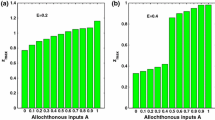Abstract
In this paper, a predator–prey model with cannibalistic effect in predator is presented. Naturally, juveniles predators are captured by their own adult predators in water population system. To reduce such conspecific capturing, alternative resource is supplied to adult predators as a supplementary food. The model is analyzed in terms of theoretical and numerical point of view. The conditions for local and global stability around existing equilibrium points, persistence, and Hopf bifurcation are derived theoretically. Numerical experiments illustrate that the extinction possibility of predator population can be reduced providing suitable alternative resources to adult predators. The impacts of alternative resource supply with the variation of other parameters are shown in the model. The dynamical relationship between the strength of cannibalism and alternative resource supply is also drawn. The model is useful specially in fishery system.











Similar content being viewed by others
References
Aiello Walter G, Freedman HI, Wu J (1992) Analysis of a model representing stage-structured population growth with state-dependent time delay. SIAM J Appl Math 52(3):855–869
Birkhoff G, Rota GC (1995) Ordinary differential equations. Ginn Boston 40(12):1992–2013
Chakraborty S, Chattopadhyay J (2011) Effect of cannibalism on a predator–prey system with nutritional value: a model based study. Dyn Syst 26(1):13–22
Choh Y, Sabelis MW, Janssen A (2017) Predatory interactions between prey affect patch selection by predators. Behav Ecol Sociobiol 7(4):66
Claessen D, De Roos AM, Persson L (2004) Population dynamic theory of size-dependent cannibalism. Proc R Soc Lond Ser Biol Sci 271:333–340
Das KP (2016) Complex dynamics and its stabilization in an eco-epidemiological model with alternative food. Model Earth Syst Environ 2(4):1–12
Das KP, Ghosh K, Chattopadhyay J (2012) Alternative food induced predator–prey oscillation in an eco-epidemiological model. Int J Evol Equ 6(2):39–61
Elgar MA, Crespi BJ (1992) Cannibalism: ecology and evolution among diverse taxa. Oxford University Press, New York
Fox LR (1975) Factors influencing cannibalism, a mechanism of population limitation in the predator Notonecta hoffmanni. Ecology 56:933–941
Freedman H, Waltman P (1984) Persistent in models of three interacting predator–prey populations. Math Biosci 68:213–231
Gard TC, Hallam TG (1979) Persistence in food web-1, Lotka–Volterra food chains. Bull Math Biol 41:877–891
Haque M (2011) A detailed study of the Beddington–DeAngelis predator–prey model. Math Biosci 234:1–16
Haque M, Sarwardi S (2016) Effect of toxicity on a harvested fishery model. Model Earth Syst Environ 2(3):122
Haque M, Zhen J, Venturino E (2008) An ecoepidemiological predator prey model with standard disease incidence. Math Methods Appl Sci 32(7):875–898
Holling CS (1959) Some characteristics of simple types of predation and parasitism. Can Entomol 91:385–398
Kar TK, Mondal PK (2011) Global dynamics and bifurcation in a delayed SIR epidemic model. Nonlinear Anal 12:2058–2068
Kumar V, Dhar J, Bhatti HS (2019) Stage-structured plant-pest-natural enemy interaction dynamics incorporating gestation delay for both pest and natural enemy. Model Earth Syst Environ 5(1):59–69
Leonardsson K (1991) Effects of cannibalism and alternative prey on population-dynamics of Saduria entomon (Isopoda). Ecology 72:1273–1285
Li MY, Muldowney JS (1996) Ageometric approach to global stability problem. SIAM J Math Anal 27(4):1070–1083
Linley PA, Joseph S (2004) Applied positive psychology: a new perspective for professional practice. In: Linley PA, Joseph S (eds) Positive psychology in practice. Wiley, Hoboken, NJ, pp 3–12
Nagumo M (1994) Uber die Lage der Integralkurven gew onlicher Differentialgleichungen. Proc Phys Math Soc 24:551
Orr BK, Murdoch WW, Bence JR (1990) Population regulation, convergence, and cannibalism in Notonecta (Hemiptera). Ecology 71:68–82
Persson L (1999) Trophic cascades: abiding heterogeneity and the trophic level concept at the end of the road. Oikos 85:385–397
Polis GA (1981) The evolution and dynamics of intraspecific predation. Annu Rev Ecol Syst 12:225–251
Polis GA (1984) Age structure component of niche width and intraspecific resource partitioning: can age groups function as ecological species? Am Nat 123:541–564
Prasad KD, Prasad B (2018) Biological pest control using cannibalistic predators and with provision of additional food: a theoretical study. Theor Ecol 11(2):191–211
Rosenzweig ML (1971) Paradox of enrichment: destabilization of exploitation ecosystems in ecological time. Science 171:385–387
Rudolf VHW (2007a) The interaction of cannibalism and omnivory: consequences for community dynamics. Ecology 882:2697–2705
Rudolf VHW (2007b) Consequences of stage-structured predators: cannibalism, behavioral effects, and trophic cascades. Ecology 88(12):2991–3003
Rudolf VHW (2007c) The influence of cannibalism and size structure on the dynamics of aquatic communities. Dissertation. University of Virginia, Charlottesville, Virginia, USA
Rudolf VHW, Armstrong J (2008) Emergent impacts of cannibalism and size refuges in prey on intraguild predation systems. Oecologia 157:675–686
Sabelis MW, van Rijn PCJ (2005) When does alternative food promote biological pest control? In: Hoddle MS (ed) Proceedings of second international symposium on biological control of arthropods, vol 2, pp 428–437
Sahoo B, Poria S (2014) Effects of supplying alternative food in a predator–prey model with harvesting. Appl Math Comput 234:150–166
Sahoo B, Poria S (2015) Effects of additional food in a delayed predator–prey model. Math Biosci 261:62–73
Sahoo B, Poria S (2016b) Effects of additional food in a susceptible-exposed-infected prey–predator model. Model Earth Syst Environ 2(3):160
Sahoo B, Das B, Samanta S (2016a) Dynamics of harvested-predator–prey model: role of alternative resources. Model Earth Syst Environ 2(3):140
Sarwardi S, Mandal MR, Gazi NH (2016) Dynamical behavior of an ecological system with Beddington–DeAngelis functional response. Model Earth Syst Environ 2:106
Sih A (1981) Stability, prey density and age/dependent interference in an aquatic insect predator, Notonecta hoffmanni. J Anim Ecol 50:625–636
Sniegula S, Golab MJ, Johansson F (2017) Cannibalism and activity rate in larval damselflies increase along a latitudinal gradient as a consequence of time constraints. BMC Evol Biol 1(1):167
Acknowledgements
We are grateful to the editor and reviewer for their valuable comments and suggestions which have immensely improved the content and presentation of this version.
Author information
Authors and Affiliations
Corresponding author
Additional information
Publisher's Note
Springer Nature remains neutral with regard to jurisdictional claims in published maps and institutional affiliations.
Rights and permissions
About this article
Cite this article
Samanta, S., Sahoo, B. & Das, B. Emergent impacts of alternative resource in cannibalistic predator–prey system. Model. Earth Syst. Environ. 7, 1595–1609 (2021). https://doi.org/10.1007/s40808-020-00884-w
Received:
Accepted:
Published:
Issue Date:
DOI: https://doi.org/10.1007/s40808-020-00884-w




